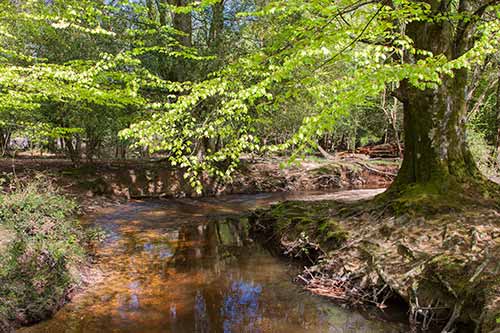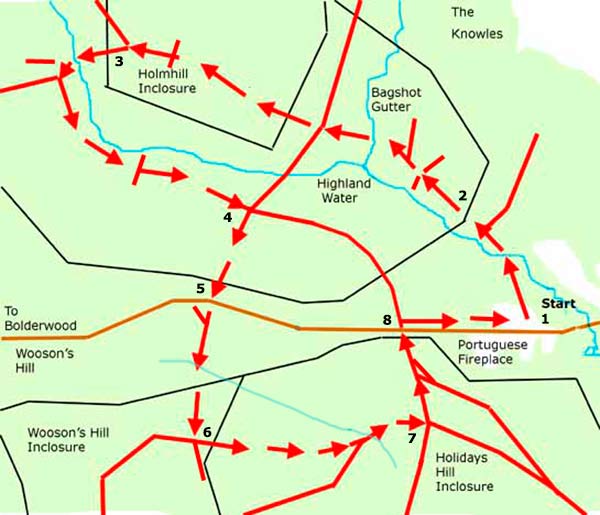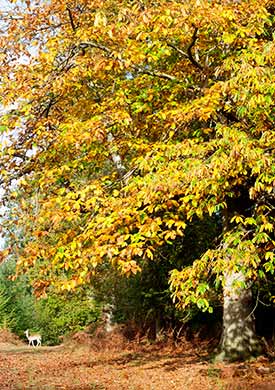New Forest Walks - Millyford Bridge and nearby woodlands
This woodland walk starts beside Highland Water and passes through Holmhill Inclosure, Wooson’s Hill Inclosure and Holidays Hill Inclosure.

Overview
At the start of this walk, below aged over-hanging boughs, steep-banked Highland Water flows over gravel beds on its way to the sea. Evidence of man’s attempts to speed the flow is visible along the way, but that does not detract from the beauty of the stream. Kingfishers and grey wagtails can sometimes be seen, and from the end of May until August, Beautiful Demoiselle damselflies dance, butterfly-like, above the stream.
Holmhill Inclosure was first set aside to grow trees way back in 1670. The original inclosure, however, was largely taken into a later inclosure of the same name created in 1815. Few trees from the original inclosure remain, although the related, substantial surrounding earthen wood-bank is in many places still evident.
This inclosure features many mature broad-leaved trees, such as oak and beech, as well as a variety of conifers, including by the ride-side a stand of larch that in winter attracts mixed flocks of twittering finches to feed – look out for siskins, redpolls and goldfinches. Notice also along here the prominent nests of southern wood ants, built into typically tall, conical shape in clearings or beside the path where warming sunlight is most likely to fall.
A little beyond Holmhill Inclosure in what is now Highland Water Inclosure, is the site of an old Stag Park. One of three such parks shown on the old map of the New Forest, they were clearly associated with deer although their exact purpose remains unclear. It has been suggested, however, that they were created in the 17th century to hold red deer newly imported from France. Earthwork remains can still be seen.
Wooson’s Hill Inclosure was first planted in 1829, and Holidays Hill Inclosure in 1811. Both comprise an attractive mixture of mature, well-spaced broadleaved and coniferous trees, with small areas of younger, regenerating conifers.
Bilberry, a plant tolerant of low light levels and acid soils, grows well in these inclosures; whilst the heart-shaped, clover-like leaves of wood-sorrel are prominent in spring and summer. Often, though, few wood-sorrel flowers appear in spring as in the shade of the trees, many of the plants depend for effective reproduction on relatively inconspicuous, self-pollinating mid-summer blooms.
Of the New Forest deer, roe deer might be present along the way, but fallow deer are the species most likely to be seen during this walk, often in small to medium sized groups. Look out for the swish of a tail, the flick of an ear or the horizontal outline of an animal’s body silhouetted against a background of lighter coloured bracken. In autumn, listen, too, for the sound of rutting deer, for this a favoured area where belligerent yet amorous bucks groan and do battle.
Notice towards the end of the walk, the Portuguese Fireplace. An adjacent interpretation panel informs: ‘This is the site of a hutted camp occupied by a Portuguese army unit during the First World War. This unit assisted the depleted local labour force in producing timber for the war effort. The Forestry Commission has retained this fireplace from the cookhouse as a memorial to the men who lived and worked here ....‘.
4.5 kilometres (2¾ miles).
Start:
Millyford Bridge car park – 4 kilometres (2½ miles) west of Lyndhurst village centre.
Terrain:
Mainly on level ground, but with a small number of gentle gradients; and mostly firm, but as sections can at times be wet and muddy, strong boots are recommended.
Refreshments:
Whilst not on the walk route, the New Forest Inn at Emery Down is a relatively short distance away - around 2 kilometres from the Millyford Bridge car park.
New Forest Tour bus route:
No

Parking
Parking is available in the Millyford Bridge car park – 4 kilometres (2½ miles) west of Lyndhurst village centre.
Walk route directions
1. Leave the car park at Millyford Bridge along a gravel track leading directly away from the road. Cross a bridge over a narrow side-stream and then cross another bridge over the main river. Notice here on both sides of the path the often water-filled meander cut off from the main flow.
Pass on the left a number of magnificent, centuries old beech trees, and equally aged hollies; cross a small clearing and go through a gate into Holmhill Inclosure.
2. Continue along the gravel track; pass over a crossroads where a grassy ride intersects the gravel track, and cross a small bridge over a tiny stream - Bagshot Gutter.

Continue straight ahead at the next crossroads where a grassy ride intersects the main track. Notice immediately on the left an area of regenerating woodland fenced to keep out commoners’ stock, and deer, and other fenced areas further along.
Go straight ahead again where the next grassy ride intersects the track, and on reaching a ‘Y’ junction, take the left fork.
3. Follow the track downhill. Re-cross Highland Water at a sturdy concrete bridge, and continue along the track as it bears round to the left - ignore a grassy ride going uphill on the right.
After a short distance, where the main gravel track swings round to the right, turn left down a lesser used gravel track running parallel to the river. Continue straight ahead where another grassy ride intersects the main track.
4. Reach a crossroad of tracks. The track straight ahead leads back to the road close to the Portuguese Fireplace, but turn right here for a slightly longer walk.
Go through a gate, and continue along what by now is a grassy ride, and just ahead, beyond a vehicle barrier, is the road.
5. Cross over the road and go straight ahead into the wood. After a short distance, meet a well-defined path joining from the right. Continue virtually straight ahead along the path, down a gentle gradient into a wooded valley bottom.
Cross a bridge over a narrow stream, and after a short distance, go through a gate set in a gap in a prominent, moss-clad wood-bank, and enter the shade of Wooson’s Hill Inclosure
After a short distance, reach a crossroads and turn left along a little-used gravel track.
6. Follow this track into Holidays Hill Inclosure. Ignore a path on the right and continue downhill to again cross the narrow stream.
7. Reach another crossroads and turn left along a substantial gravel track. Almost immediately meet a ‘Y’ junction, take the left hand fork and then shortly after pass a track on the right. Go through a gate to reach the road.
8. Turn right and pass on the right the Portuguese Fireplace. Continue along the road for a short distance to reach the Millyford Bridge car park. (Notice on the left close to the car park entrance, a quite large, rectangular concrete block amongst a group of small trees; and across the road, the outline of building foundations - further evidence of war-time occupation?
Quick links
More links
Search this site

